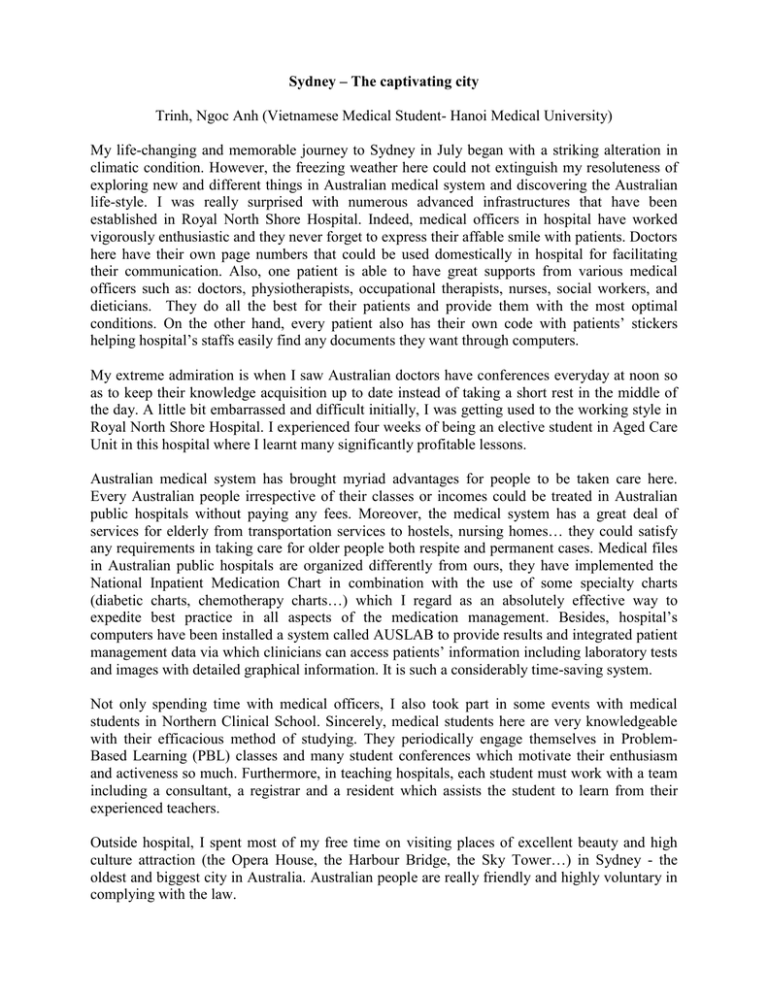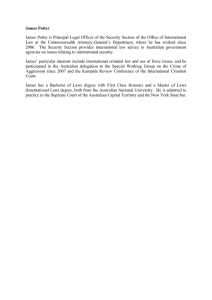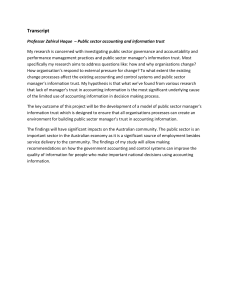Sydney – The captivating city
advertisement

Sydney – The captivating city Trinh, Ngoc Anh (Vietnamese Medical Student- Hanoi Medical University) My life-changing and memorable journey to Sydney in July began with a striking alteration in climatic condition. However, the freezing weather here could not extinguish my resoluteness of exploring new and different things in Australian medical system and discovering the Australian life-style. I was really surprised with numerous advanced infrastructures that have been established in Royal North Shore Hospital. Indeed, medical officers in hospital have worked vigorously enthusiastic and they never forget to express their affable smile with patients. Doctors here have their own page numbers that could be used domestically in hospital for facilitating their communication. Also, one patient is able to have great supports from various medical officers such as: doctors, physiotherapists, occupational therapists, nurses, social workers, and dieticians. They do all the best for their patients and provide them with the most optimal conditions. On the other hand, every patient also has their own code with patients’ stickers helping hospital’s staffs easily find any documents they want through computers. My extreme admiration is when I saw Australian doctors have conferences everyday at noon so as to keep their knowledge acquisition up to date instead of taking a short rest in the middle of the day. A little bit embarrassed and difficult initially, I was getting used to the working style in Royal North Shore Hospital. I experienced four weeks of being an elective student in Aged Care Unit in this hospital where I learnt many significantly profitable lessons. Australian medical system has brought myriad advantages for people to be taken care here. Every Australian people irrespective of their classes or incomes could be treated in Australian public hospitals without paying any fees. Moreover, the medical system has a great deal of services for elderly from transportation services to hostels, nursing homes… they could satisfy any requirements in taking care for older people both respite and permanent cases. Medical files in Australian public hospitals are organized differently from ours, they have implemented the National Inpatient Medication Chart in combination with the use of some specialty charts (diabetic charts, chemotherapy charts…) which I regard as an absolutely effective way to expedite best practice in all aspects of the medication management. Besides, hospital’s computers have been installed a system called AUSLAB to provide results and integrated patient management data via which clinicians can access patients’ information including laboratory tests and images with detailed graphical information. It is such a considerably time-saving system. Not only spending time with medical officers, I also took part in some events with medical students in Northern Clinical School. Sincerely, medical students here are very knowledgeable with their efficacious method of studying. They periodically engage themselves in ProblemBased Learning (PBL) classes and many student conferences which motivate their enthusiasm and activeness so much. Furthermore, in teaching hospitals, each student must work with a team including a consultant, a registrar and a resident which assists the student to learn from their experienced teachers. Outside hospital, I spent most of my free time on visiting places of excellent beauty and high culture attraction (the Opera House, the Harbour Bridge, the Sky Tower…) in Sydney - the oldest and biggest city in Australia. Australian people are really friendly and highly voluntary in complying with the law. Thanks to The Hoc Mai Foundation, thanks to the great support from senior doctors in Australia and Vietnam who give me this wonderful opportunity to open my eye in a developed country‘s hospital.




